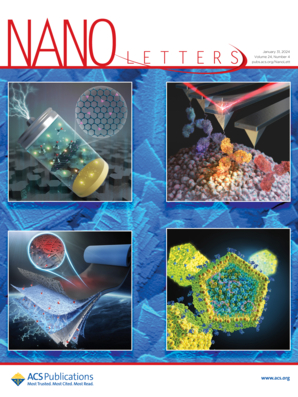Stress-Dispersed Nanoconstruction of CoMoP Anode: Improved Na-Storage Stability and Reversibility
IF 9.6
1区 材料科学
Q1 CHEMISTRY, MULTIDISCIPLINARY
引用次数: 0
Abstract
Metal phosphide anode materials encounter poor reversibility of the discharge product (metal and Na3P) and large volume variation, resulting in low initial Coulombic efficiency (ICE) and severe capacity degradation. Herein, a bimetallic phosphide (CoMoP) with three-dimensional ordered porous (3DOP) nanoconstruction was fabricated, which presents a reduced Gibbs free energy change (ΔG) of redox reaction between Co–Mo/Na3P and CoMoP and improved conductivity compared to CoP and MoP. Additionally, the 3DOP architecture could disperse stress and reduce strain during cycling, thus improving structural stability of CoMoP. In situ and ex situ characterizations and electrochemical measurements suggest that 3DOP CoMoP exhibits highly reversible sodium storage with an ICE of 58% at 0.1 A g–1, enhanced reaction dynamics, and good cycling stability with around 0.04% capacity decay per cycle at 1 A g–1 after 1000 cycles. Consequently, this work offers a new perspective to solve issues of reversibility of redox chemistry and volume expansion for secondary batteries.

CoMoP 阳极的应力分散纳米结构:提高钠贮存稳定性和可逆性
金属磷化物阳极材料的放电产物(金属和 Na3P)可逆性差,体积变化大,导致初始库仑效率(ICE)低,容量衰减严重。本文制备了一种具有三维有序多孔(3DOP)纳米结构的双金属磷化物(CoMoP),与 CoP 和 MoP 相比,它降低了 Co-Mo/Na3P 与 CoMoP 之间氧化还原反应的吉布斯自由能变化(ΔG),提高了导电性。此外,3DOP 结构可以分散应力,减少循环过程中的应变,从而提高 CoMoP 的结构稳定性。原位和非原位表征以及电化学测量结果表明,3DOP CoMoP 具有高度可逆的钠存储能力,在 0.1 A g-1 时的 ICE 为 58%,反应动力学增强,循环稳定性良好,在 1 A g-1 循环 1000 次后,每次循环的容量衰减约为 0.04%。因此,这项研究为解决二次电池氧化还原化学的可逆性和体积膨胀问题提供了一个新的视角。
本文章由计算机程序翻译,如有差异,请以英文原文为准。
求助全文
约1分钟内获得全文
求助全文
来源期刊

Nano Letters
工程技术-材料科学:综合
CiteScore
16.80
自引率
2.80%
发文量
1182
审稿时长
1.4 months
期刊介绍:
Nano Letters serves as a dynamic platform for promptly disseminating original results in fundamental, applied, and emerging research across all facets of nanoscience and nanotechnology. A pivotal criterion for inclusion within Nano Letters is the convergence of at least two different areas or disciplines, ensuring a rich interdisciplinary scope. The journal is dedicated to fostering exploration in diverse areas, including:
- Experimental and theoretical findings on physical, chemical, and biological phenomena at the nanoscale
- Synthesis, characterization, and processing of organic, inorganic, polymer, and hybrid nanomaterials through physical, chemical, and biological methodologies
- Modeling and simulation of synthetic, assembly, and interaction processes
- Realization of integrated nanostructures and nano-engineered devices exhibiting advanced performance
- Applications of nanoscale materials in living and environmental systems
Nano Letters is committed to advancing and showcasing groundbreaking research that intersects various domains, fostering innovation and collaboration in the ever-evolving field of nanoscience and nanotechnology.
 求助内容:
求助内容: 应助结果提醒方式:
应助结果提醒方式:


